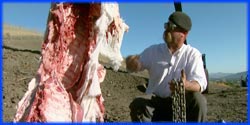


Premier Date: October 26, 2011
confirmed (1st half) / busted (2nd half)
At the bomb range, Adam and Jamie set up a piece of C-4 and ignited it remotely. The material burned for 2 minutes without exploding and registered temperatures of 1,000 °F (538 °C). Setting up a stove from two bricks and an oven rack, they were able to warm a military MRE ration somewhat. For comparison purposes, they ignited 1 oz (28 g) samples of C-4 and three other fuels (hexamethylenetetramine, 1,3,5-trioxane, and chafing-dish fuel) under pots of water and measured the peak temperature and time to burn out. HMTA achieved a higher temperature than the other three, but the speed with which the C-4 burned led Adam to decide that it could be used as a workable cooking fuel.
For sensitivity tests, they rigged a full, 7 lb (3.2 kg) cooking pot to fall on a piece of burning C-4 from 3 ft (91 cm), then set up a robotic leg in a combat boot to stomp on it. Neither of these trials produced an explosion, so they dropped a 90 lb (41 kg) anvil on the material, without success. Shooting at the C-4 with different .308 rifle cartridges — standard, tracer, incendiary — failed to trigger an explosion as well. Finally, Adam and Jamie set up a thermite charge to drip molten material at 4,500 °F (2,482 °C) onto the C-4, thinking that extreme heat might make it sensitive enough to detonate. This test failed as well, and Jamie noted that C-4 was formulated to be stable unless set off by a blasting cap. He and Adam judged the first half of the myth as confirmed, but the second half as busted.
plausible
The Build Team set three criteria for success: ease of throwing, enough power to cleanly remove a head, and ability to contain it while being retrieved. After each member designed a different prototype, the three devices were tested against a pig neck with Buster’s head mounted on it. All three could be thrown to land on the head from 10 ft (3.0 m). Tory’s weapon, a spinning ring on a cable with a salad bowl to hold the head, came the closest to a full decapitation.
After a few refinements to his design, he was able to take the head off and have it retained within the device. Kari and Grant set up a combat situation, involving one moving enemy dummy and a second that could pop up from behind a screen. Tory hit the pop-up enemy with a glancing blow and knocked it down, but could not land his device on the moving one. Based on these results, the team decided that the flying guillotine was plausible as an assassination weapon, but not in combat.
Previous: Episode 174: Duct Tape Plane